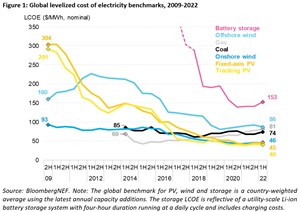 The cost of new-build onshore wind has risen 7% year on year, and fixed-axis solar has jumped 14%, according to the latest analysis by research company BloombergNEF (BNEF). The global benchmark levelized cost of electricity, or LCOE, has temporarily retreated to where it was in 2019. Cost rises are linked to increases in the cost of materials, freight, fuel and labor.
The cost of new-build onshore wind has risen 7% year on year, and fixed-axis solar has jumped 14%, according to the latest analysis by research company BloombergNEF (BNEF). The global benchmark levelized cost of electricity, or LCOE, has temporarily retreated to where it was in 2019. Cost rises are linked to increases in the cost of materials, freight, fuel and labor.BloombergNEF’s estimates for the global LCOE for utility-scale PV and onshore wind rose to $45 and $46 per megawatt-hour (MWh), respectively, in the first half of 2022. Despite losing some ground, this still marks an 86% and 46% reduction since 2010 in nominal terms. Global benchmarks conceal a range of country-level estimates that vary according to market maturity, resource availability, project characteristics, local financing conditions and labor costs. The cheapest renewable power projects in the first half of 2022 were able to achieve an LCOE of $19/MWh, as in best-in-class onshore wind farms in Brazil, and $21/MWh for tracking PV farms in Chile, and $57/MWh for offshore wind in Denmark. If the offshore transmission costs are excluded, the latter estimate falls to $43/MWh.
Despite temporary cost rises for renewables, the gap to fossil fuel power generation continues to widen due to fuel and carbon prices rising even faster. New-build onshore wind and solar projects are now around 40% lower than BNEF’s global benchmarks for new coal- and gas-fired power. The latter cost at $74 and $81 per MWh, respectively.
While demand for low-carbon technologies in the energy sector bounced back strongly in the second half of 2021, supply has struggled to keep up. Global supply chains were weakened by investment deferrals, staff layoffs, early retirement of assets and lockdowns. Trade flows have been disrupted by challenges in logistics and transportation, trade barriers, and a re-wiring of relationships following Russia’s invasion of Ukraine.
Shipping rates from Asia have fallen from their peak in September 2021 but are still five times higher than in 2019. Shipping routes from Asia are critical to deliver solar panels, inverters, batteries and other components. More recently, labor costs started to rise. In the US, labor costs 16% more than 18 months ago. Since February 2022, the price of key metals, including aluminum, copper, cobalt and molybdenum has dropped, but remains relatively high.
Renewables remain the cheapest source of new bulk power in countries comprising two-thirds of the world population and nine-tenths of electricity generation.
